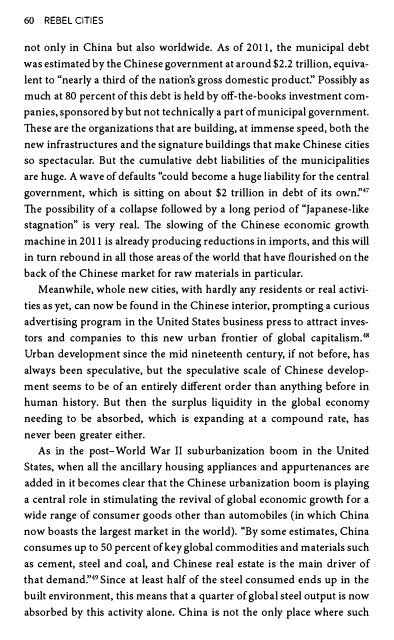Rebel Cities-David Harvey
Rebel Cities-David Harvey
Rebel Cities-David Harvey
- No tags were found...
Create successful ePaper yourself
Turn your PDF publications into a flip-book with our unique Google optimized e-Paper software.
60 REBEL CITIESnot only in China but also worldwide. As of 201 1, the municipal debtwas estimated by the Chinese government at around $2.2 trillion, equivalentto "nearly a third of the nation's gross domestic product:' Possibly asmuch at 80 percent of this debt is held by off-the-books investment companies,sponsored by but not technically a part of municipal government.These are the organizations that are building, at immense speed, both thenew infrastructures and the signature buildings that make Chinese citiesso spectacular. But the cumulative debt liabilities of the municipalitiesare huge. A wave of defaults "could become a huge liability for the centralgovernment, which is sitting on about $2 trillion in debt of its own:'"The possibility of a collapse followed by a long period of "Japanese-likestagnation" is very real. The slowing of the Chinese economic growthmachine in 201 1 is already producing reductions in imports, and this willin turn rebound in all those areas of the world that have flourished on theback of the Chinese market fo r raw materials in particular.Meanwhile, whole new cities, with hardly any residents or real activitiesas yet, can now be found in the Chinese interior, prompting a curiousadvertising program in the United States business press to attract investorsand companies to this new urban frontier of global capitalism.'18Urban development since the mid nineteenth century, if not before, hasalways been speculative, but the speculative scale of Chinese developmentseems to be of an entirely different order than anything before inhuman history. But then the surplus liquidity in the global economyneeding to be absorbed, which is expanding at a compound rate, hasnever been greater either.As in the post-World War II sub urbanization boom in the UnitedStates, when all the ancillary housing appliances and appurtenances areadded in it becomes clear that the Chinese urbanization boom is playinga central role in stimulating the revival of global economic growth for awide range of consumer goods other than automobiles (in which Chinanow boasts the largest market in the world). "By some estimates, Chinaconsumes up to 50 percent of key global commodities and materials suchas cement, steel and coal, and Chinese real estate is the main driver ofthat demand:'"9 Since at least half of the steel consumed ends up in thebuilt environment, this means that a quarter of global steel output is nowabsorbed by this activity alone. China is not the only place where such


